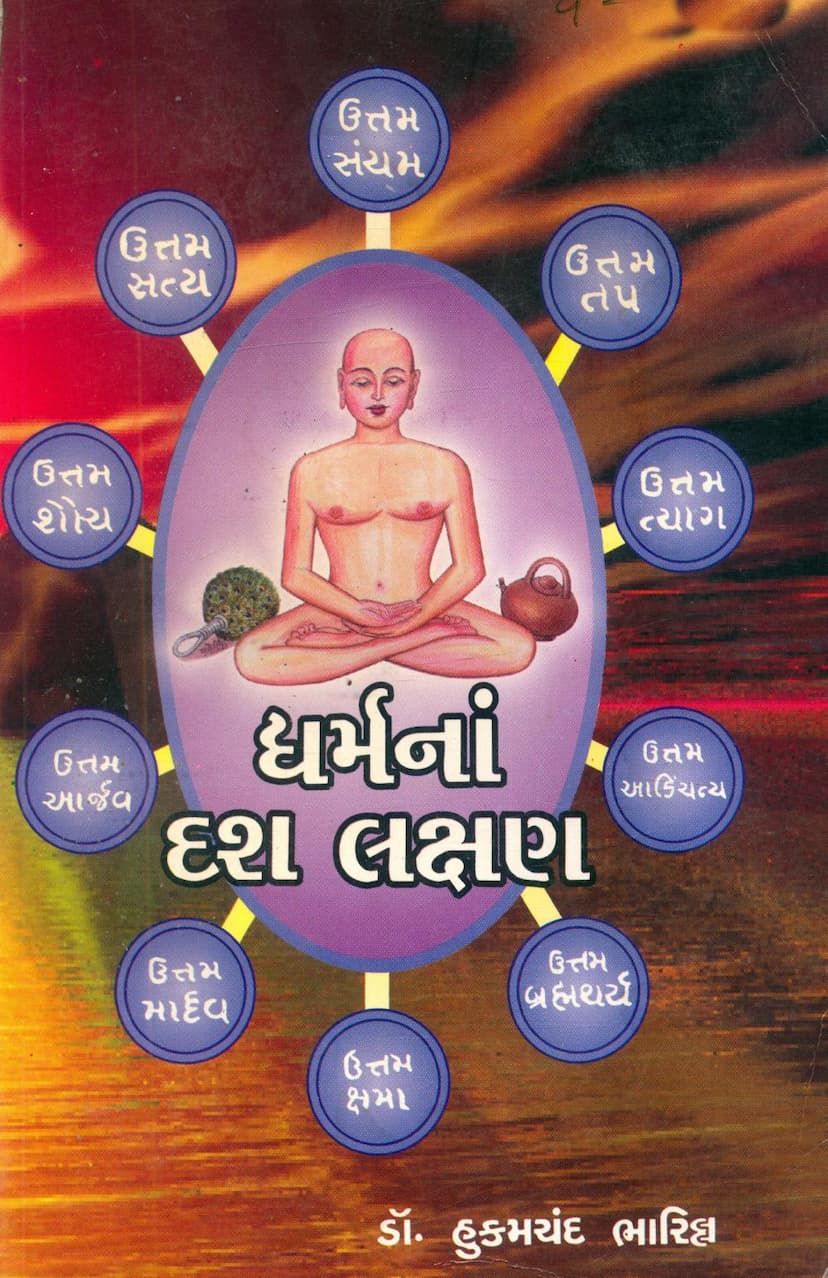Dharmna Dash Lakshan
Added to library: September 1, 2025

Summary
Here's a comprehensive summary of the Jain text "Dharmna Dash Lakshan" based on the provided pages:
Book Title: Dharmna Dash Lakshan (The Ten Characteristics of Dharma) Author: Dr. Hukamchand Bharilla Translator: Ramniklal Maniklal Shah Publisher: Pandit Todarmal Smarak Trust, Jaipur
Overview:
This book, "Dharmna Dash Lakshan," is a profound exploration of the ten cardinal virtues or characteristics of Dharma in Jainism. It aims to present these fundamental principles in a way that is accessible and relevant to modern readers, going beyond mere ritualistic observance to delve into their deeper spiritual and philosophical meaning. The text emphasizes that these ten characteristics are not separate entities but rather interconnected manifestations of the soul's inherent nature.
Key Themes and Content:
The book is structured around the exposition of ten core virtues, along with an introduction to the Daslakshan Mahaparva (Great Festival of Ten Characteristics) and a concluding section on Kshama Vani (the day of Forgiveness).
-
Daslakshan Mahaparva: This chapter introduces the significance of the Daslakshan festival, highlighting it as a period of intense spiritual devotion, self-discipline, and contemplation. It distinguishes Jain festivals like Daslakshan from other festivals by emphasizing the element of tyaga (renunciation) rather than indulgence. The text categorizes festivals into eternal (Shaashwat) and temporal (Saamayik), with Daslakshan being a timeless, eternal festival rooted in spiritual emotions.
-
The Ten Characteristics of Dharma: The core of the book is dedicated to explaining each of the ten virtues in detail. These are presented as:
- Uttam Kshama (Supreme Forgiveness): Forgiveness is described as the soul's innate nature, which, when manifested, leads to peace by eliminating anger. The text explains that true forgiveness isn't just the absence of anger but the absence of the anantānu bandhī (eternally binding) anger.
- Uttam Mardav (Supreme Humility/Gentleness): Humility is presented as the absence of pride and arrogance, the opposite of maan (conceit). The book discusses how pride can manifest in various forms, driven by knowledge, status, wealth, or physical attributes, and how true humility stems from recognizing the equality of all souls.
- Uttam Ārjav (Supreme Straightforwardness/Honesty): Straightforwardness is explained as the absence of deceit and duplicity (maya). The text emphasizes the importance of congruence between one's thoughts, words, and actions, and contrasts superficial politeness with genuine sincerity.
- Uttam Shauch (Supreme Purity/Contentment): Purity is defined as the absence of greed (lobha). The book differentiates between the commonly understood monetary greed and broader forms of greed related to desires, achievements, and even spiritual attainments. It highlights that true contentment is found in spiritual realization, not material accumulation.
- Uttam Satya (Supreme Truth): Truth is not merely about speaking truthfully but about understanding and living in accordance with the true nature of reality, the soul. The text emphasizes that the ultimate truth lies within the soul and that mistaking external appearances or intellectual knowledge for the true Dharma is a form of untruth.
- Uttam Sanyam (Supreme Self-Control): Self-control is presented as the mastery over the senses and the mind. It involves restraining the five senses and the mind from their outward indulgence and redirecting their focus inward towards the soul. The book critiques superficial interpretations of self-control that focus only on external actions without addressing the internal tendencies.
- Uttam Tap (Supreme Austerity): Tapasya is explained not just as physical hardship or fasting, but as the internal discipline of renouncing desires and dwelling in the true nature of the soul. The book differentiates between external and internal austerities, emphasizing the latter's supreme importance.
- Uttam Tyaag (Supreme Renunciation): Renunciation is distinguished from charity. While charity involves giving, true renunciation is the detachment from all external and internal possessions, including the ego and desires, leading to a state of non-possession. The ultimate renunciation is the letting go of all worldly attachments and identifying solely with the pure soul.
- Uttam Ākinchanya (Supreme Non-possession): This characteristic is closely linked to Tyaag and emphasizes the complete absence of attachment to any external or internal 'possessions,' including the sense of 'mine.' It is the state of being devoid of any form of accumulation, both material and psychological.
- Uttam Brahmcharya (Supreme Chastity/Celibacy): This virtue is described as dwelling in the soul. It transcends the mere physical abstinence from sexual activity and encompasses the control of all senses and the mind, ultimately leading to spiritual purity and unbroken communion with the soul. The book argues for a comprehensive understanding of Brahmcharya that extends beyond physical actions to mental and verbal control.
-
Kshama Vani: This final section discusses the practice of seeking and offering forgiveness, highlighting how it often becomes a superficial ritual rather than a genuine internal transformation. It encourages a deeper reflection on the meaning of forgiveness and its role in purifying the mind and fostering genuine reconciliation.
Author's Approach and Style:
Dr. Hukamchand Bharilla is presented as a highly respected scholar and spiritual speaker, deeply influenced by the teachings of Pujya Shri Kanji Swami. His writing style is praised for its clarity, accessibility, and ability to connect profound spiritual concepts with the everyday experiences of the readers. He uses insightful reasoning, logical arguments, and occasional gentle critiques of prevailing societal practices to illuminate the essence of these virtues. The book incorporates numerous references to Jain scriptures and philosophical traditions to substantiate its points.
Overall Significance:
"Dharmna Dash Lakshan" serves as a guide for spiritual aspirants seeking to understand and practice the fundamental tenets of Jainism. It aims to inspire individuals to cultivate these virtues within themselves, leading to personal growth, inner peace, and ultimately, spiritual liberation (moksha). The book's widespread publication in multiple languages and its consistent popularity attest to its enduring relevance and the author's effective communication of complex spiritual truths.